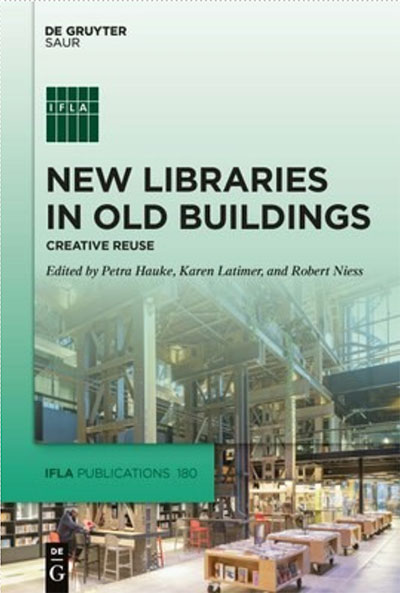Book Reviews — “New Libraries in Old Buildings: Creative Reuse”
Casey Conlin
Library Sustainability Coordinator, Mid-Hudson Library System
E-mail: cconlin@midhudson.org

New Libraries in Old Buildings
— Creative Reuse
Edited by: Petra Hauke, Karen Latimer and Robert Niess
Berlin/Boston: De Gruyter Saur, 2021
ISBN 9783110679663
(IFLA Publications; No 180)
With programs and spaces that build local resiliency through connections between neighbors, and borrowing services that facilitate communities sharing finite resources to create social equity while limiting resource consumption and financial costs, libraries are a key part of a sustainable future on our planet. The value of the library to the people it serves justifies the economic and ecological costs of creating and updating library spaces, but in IFLA’s latest publication, New Libraries in Old Buildings: Creative Reuse, editors Petra Hauke, Karen Latimer, and Robert Niess gather nineteen case studies from public and academic library buildings all over the world to challenge the idea that great library spaces can’t be created in existing buildings, and demonstrate that adaptation of old buildings can provide benefits which can’t be realized in new construction. New Libraries in Old Buildings, available now through open access, should be on the reading list for any library administrators and stakeholders looking to update their library space, architects that specialize in library construction, and anyone interested in creating more sustainable libraries.
The reuse of existing buildings as library spaces requires a thorough understanding of the existing buildings and greater creativity than new construction, but reuse offers an opportunity for libraries to lead the way in finding solutions to issues faced by communities and organizations all over the world now grappling with a need for greater services and limitations imposed by climate change, historical building patterns, and empty buildings. In the case study, A Fire Hall Reused for Windsor Public Library’s John Muir Branch in Ontario, Canada, Rebekah Mayer describes the city’s determination to show an old fire hall could become a library to inspire others to rebuild the community. Hauke, Latimer, and Niess point out, old buildings have characters and aesthetic value that are difficult to capture in new construction, and many old buildings inspire a sense of pride and identity in residents who prize older buildings for their place in the community’s history and cultural identity, as in Tara Murray Grove’s case study, Transforming a Match Factory into the American Philatelic Research Library in Bellefonte, Pennsylvania. Older buildings are often well-situated geographically, providing greater access and walkability in villages, towns, and cities that have been built out over the course of decades or centuries of development. Reusing buildings reduces grey energy, which includes the energy expended in the initial creation of a building, energy expended through demolition and disposal, and the energy needed to rebuild. New architectural techniques for building reuse along with updated techniques, materials, and equipment for building systems and rising hard costs for construction and demolition mean that reuse of buildings no longer has to be considered a luxury in comparison to new construction. Of course, not all buildings can be easily reborn as libraries owing to the nature of the services libraries provide to their communities and the structural requirements for storing books, and the editors offer an overview of several types of historical building and the common benefits and drawbacks to transforming each into a library.
As social and professional life transform in the wake of Covid, and local business models and storefronts adapt to a world where ecommerce plays a larger role, more buildings will need to find new uses or fall into irreversible disrepair. Libraries will have an opportunity to play a greater role in creating resilient communities, and these existing spaces can help them meet patrons where they are while mitigating the library’s contribution to climate change. The guidance and case studies in New Libraries in Old Buildings: Creative Reuse provide an informative overview of the processes involved in reusing an old building for library purposes while focusing on community needs, and the information gathered in the book will inspire more sustainable library facilities in the future.
Download:
Website: https://www.ibi.hu-berlin.de/de/studium/studprojekte/buchidee/bi19-20/startseite